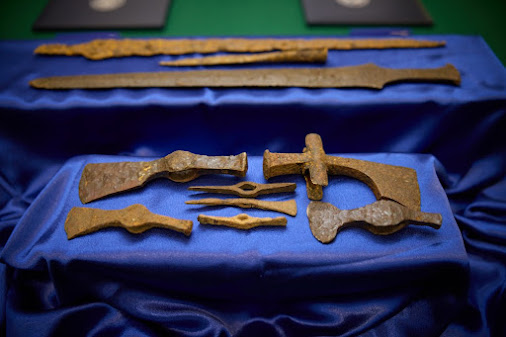Office of the President of Ukraine: '
A ceremony of returning cultural property stolen from the temporarily occupied territories of Ukraine was held in Washington with the participation of the President'
21 September 2023
During a working visit to the United States, President Volodymyr Zelenskyy took part in a ceremony of returning cultural property stolen by Russian invaders from the temporarily occupied territories of Ukraine [...] and [...] confiscated by U.S. law enforcement agencies.[...]
In June 2022, the U.S. Customs and Border Protection detained an antique, which, after examination, turned out to be a European iron axe from the 17th century with a hammer on the back. The axe was illegally exported from Ukraine to the United States.
Also last June, artifacts smuggled into the United States from Russia were seized. In particular, three 17th-century iron axes, three 17th-century mattocks, two 6th-century BC Scythian iron acinaces, and one iron spearhead dating from approximately 500-1200 BC.
These artifacts were confiscated for transfer to the Embassy of Ukraine in the United States under administrative procedure.
Plus: the usual peptalk speaking as per normal, heritage values, bla bla.
I guess the first axe really was being exported by one of Ukraine's many eBay dealers, active before and during the War. I bet it's the one in the left foreground. The blunt peen could be used to knock nails (or wooden pegs) into a structure.
There is potential for a very satisfying PhD thesis for someone on
"The Morphology, Characteristics and function of Post-Medieval Axes in Northern Europe (15th to 19th centuries)" - or maybe Europe generally? I don't think there is a monographic treatment (stand to be corrected). Dealers (no, I'll not name-names, I am sure you can come up with some) habitually [literally habitually] sell these and other forms as "Viking Axes", anything handmade with an odd-shaped blade and very-very rusty. The ones I saw in an auction house a year ago were quite specific in form, and on the Polish online sales-place Allegro I spotted the exact same form of axes in the "technological antiques" (ie byegones from the backs of rural barns). I am sure the dealers' ones were recent axes from Poland (Maybe the same form occurs in neighbouring countries) but this was no older than the nineteenth century. I do not know how this one is dated to the "17th century", the forms of utilitarian iron tools is (a) limited by the technique of forging and (b) tended to be very conservative over time.
The June 2023 ones, the same would apply to the axes. They are of vaguely-Viking-looking form, but are not. Again, I could not say how they are dated, perhaps they know where they were dug up (?). Weird forms like this could be spotted in manuscript illustrations, in manuscripts, early woodcuts, paintings. They are specialist woodworking tgools (perhaps boat-building? Just a guess). The one back right is robust and could [I'd suggest would] have been used to split logs longitudinally, with a mighty whack and then hammering the peen ito the wood until it split. It is not a battle axe, too heavy to carry about for one thing. The three hand-picks (NOT "mattocks"!) are small hand tools, used for dressing stone (similar tools are used for making stone-slab roofing tiles with the spike for making teh nail holes - but I am not sure whether such tiles were made in Russia/Ukraine, can't recall reading abouty them or seeing any). Totally beats me how they are dated. I have one bought new in Jack's in Colchester in the 1980s - used it as an excavation tool. Mine too is now as rusty as these as it's been in a leaky shed at my Mums for the last 37 years. Two of them are not ancient IMO. At the back... well, unlikely that the spearhead is as old as 1200 BC, wherever it is from. It probably is ancient, but why it is not Early Medieval beats me (given my background, it screams "Anglo-Saxon" to me, but it can't be - but it is to that period that I'd start looking for parallels, not the early Metal Ages). It's a fuzzy picture but the crud on it looks plausible. The sword behind it (now is that really an
akinakes (
here too) - I really doubt it, though it has to be admitted that they were variable is shape and size) is equally cruddy and until there are better photos deserves (or rather the dealer selling it as ancient) the benefit of doubt... But then, what links it specifically with Ukraine? The akinakes (the real one) was Achaemenid in origin and it and its derivatives occurred along a wide band of steppe between Crimean and Pesoia if not beyond.
The other one, I can only ask WTF? To my eye this looks for all the world like a recently-forged replica with an oxide patina. From that photo, I really cannot accept that it is anything else. But note that it is the same shape and size as the cruddy one, which has lost its tii and the end of the hilt. Is this a replica sold with the first to give an idea how it originally looked? So the dealer was not cheating, but making something more marketable. But then.... this replica (if that's what it is) draws attention to something else. How was the hilt finished? There are no rivet holes for hilt plates, nothing making a guard (though these does not have to be) no pommel as such (akinakes generally have one). IMO you cant just have some filler plates making a handgrip (OK, maybe glued to the metal?) and bound round tightly with tapes or leather strips to make a handgrip. IMO this would work loose in no time (and what rain-proof glue was there in the centuries BC?). This whole sword business looks a bit fishy to me.
But this is all object-centric divagation. These items are off the antiquities market, which we all know is a swamp, so of course they are mis-described and now what they are represented as. That's par for the course. And that the Americans are once again using antiquities to score a point without any real caere as to what it is they are "repatriating" - they do it all the time (vide:
Kalmakara ('Western Cave') Griffin the the
dubious documents and @antiquities@ from the Abu Sayyaf raid) What I think is very clear that this is what's happening here. Hundreds of looted antiquiteies (real ones) are being exported from Ukraine, and not a few of them are going to the US, but this is the best Homeland Security could come up with for Zelensky's visit. A pathetic showing. let's note the phrase above: "smuggled into the United States
from Russia". Given the rather unspecific/generic shape of most of these artefacts, what (apart from modern politics) determined that these objects should go to Ukraine? Can the US authorities explain that? Is this not an example of US instrumentally treating narratives of "X destroying/stealing cultural property" to create the picture of an evil Other [where a few years aggo X was "ISIL", and now it's "Russia"], regardless of what the facts are, or how securely one can actually justify these easy slogans.
What actually links this ONE sale and the whole picture of "Russian theft" the US is trying to create? (and this is by no means a slight attack on the Ukrainian delegation Слава Україні!)






F7JxkWvWsAENX5.jpg)




















